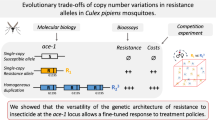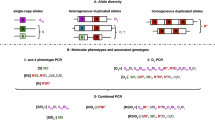Abstract
InCulex pipiens mosquitoes, AChE1 encoded by the locusAce.1 is the target of organophosphorus and carbamate insecticides. In several resistant strains homozygous forAce.1 RR, insensitive AChE1 is exclusively found. An unusual situation occurs in two Caribbean resistant strains where each mosquito, at each generation, displays a mixture of sensitive and insensitive AChE1. These mosquitoes are not heterozygotes,Ace.1 RS, as preimaginal mortalities cannot account for the lethality of both homozygous classes. This situation is best explained by the existence of twoAce.1 loci, coding, respectively, a sensitive and an insensitive AChE1. Thus, we suggest that in the Caribbean a duplication of theAce.1 locus occurred before the appearance of insecticide resistance at one of the two copies.
Similar content being viewed by others
References
Aldridge, W. N. (1950). Some properties of specific cholinesterase with particular reference to the mechanism of inhibition by diethylp-nitrophenyl thiphosphate (E605) and analogues.Biochem. J. 46451.
Arpagaus, M., and Toutant, J.-P. (1985). Polymorphism of acetylcholinesterase in adultPieris brassicae heads. Evidence for detergent-insensitive and Triton X-100-interacting forms.Neurochem. Int. 7793.
Bisset, J., Rodriguez, M., Diaz, C., Ortiz, E., Marquetti, M. C., and Hemingway, J. (1990). The mechanisms of organophosphate and carbamate resistance inCulex quinquefasciatus (Diptera: Culicidae) from Cuba.Bull. Entomol. Res. 80245.
Bourguet, D., Raymond, M., Fournier, D., Malcolm, C. A., Toutant, J.-P. and Arpagaus, M. (1996a). Existence of two acetylcholinesterases in the mosquitoCulex pipiens (Diptera: Culicidae).J. Neurochem. 672115.
Bourguet, D., Pasteur, N., Bisset, J., and Raymond, M. (1996b). Determination ofAce.1 genotypes in single mosquitoes: toward an ecumenical biochemical testPest. Biochem. Physiol. 55 (in press).
Bourguet, D., Capela, R., and Raymond, M. (1996c). An insensitive acetylcholinesterase inCulex pipiens L. mosquitoes from Portugal.J. Econ. Entomol. 89 (in press).
Ellman, G. L., Courtney, K. D., Andres, V., and Featherstone, R. M. (1961). A new and rapid colorimetric determination of acetylcholinesterase activity.Biochem. Pharmacol. 788.
ffrench-Constant, R. H., Rocheleau, T. A., Steichen, J. C., and Chalmers, A. E. (1993). A point mutation in aDrosophila GABA receptor confers insecticide resistance.Nature 363449.
Fournier, D., and Mutéro, A. (1994). Modification of acetylcholinesterase as a mechanism of resistance to insecticides.Comp. Biochem. Physiol. 10819.
Georghiou, G. P., Metcalf, R. L., and Gidden, F. E. (1966). Carbamate resistance in mosquitoes: selection ofCulex fatigans Wied. for resistance to Baygon.Bull. WHO 35691.
Guillemaud, T., Rooker, S., Pasteur, N., and Raymond, M. (1996). Testing the unique amplification and the worldwide migration hypothesis of insecticide resistance genes with sequence data.Heredity (in press).
Hama, H. (1980). Mechanism of insecticide resistance in green rice leafhopper and small brown planthopper.Rev. Plant Prot. Res. 1354.
Irving-Bell, R. J. (1983). Cytoplasmic incompatibility within and betweenCulex molestus andCx. quinquefasciatus (Diptera: Culicidae).J. Med. Entomol. 2044.
Karnovsky, M. J., and Roots, L. J. (1964). A “direct-coloring” thiocholine method for cholinesterases.J. Histochem. Cytochem. 12219.
Magnin, M., Pasteur, N., and Raymond, M. (1987). Multiple incompatibilities within populations ofCulex pipiens L. in southern France.Genetica 74125.
Mutéro, A., Pralavorio, M., Bride, J.-M., and Fournier, D. (1994). Resistance-associated point mutations in insecticide-insensitive acetylcholinesterase.Proc. Natl. Acad. Sci. USA 915922.
Mottram, P., Kay, B. H., and Fanning, I. D. (1994). Development and survival ofCulex sitiens Wiedemann (Diptera: Culicidae) in relation to temperature and salinity.J. Aust. Entomol. Soc. 3381.
Oppenoorth, F. J. (1985). Biochemistry and genetics of insecticide resistance. In Kerkut, G. A., and Gilbert, L. I. (eds.),Comprehensive Insect Physiology, Biochemistry and Pharmacology, Vol. 12 Pergamon, New York, p. 731.
Pasteur, N., Raymond, M., Rousset, F., Bergé, J.-B., Amichot, M., Pauron, D., Cuany, A., and Fournier, D. (1996). Cloning and detection of insecticide resistance genes. In Crampton, J. M., Beard, C. B., and Louis, K. (eds.),The Molecular Biology of Insect Disease Vectors: Method Manual World Health Organization, Chapman. London pp. 399–419.
Qiao, C.-L., and Raymond, M. (1995). The same esterase B1 haplotype is amplified in insecticide resistant mosquitoes of theCulex pipiens complex from the Americas and China.Heredity 74339.
Raymond, M., and Marquine, M. (1994). Evolution of insecticide resistance inCulex pipiens populations: The Corsican paradox.J. Evol. Biol. 7315.
Raymond, M., Fournier, D., Bride, J.-M., Cuany, A., Bergé, J.-B., and Magnin, M. (1986). Identification of resistance mechanisms inCulex pipiens L. (Diptera: Culicidae) from Southern France: Insensitive acetylcholinesterase and detoxifying oxidases.J. Econ. Entomol. 791472.
Smissaert, H. R. (1964). Cholinesterase inhibition in spider mites susceptible and resistant to organophosphate.Science 143129.
Yébakima, A., Raymond, M., Marquine, M., and Pasteur, N. (1995). Resistance to organophosphorous insecticides inCulex pipiens quinquefasciatus (Diptera: Culicidae) from Martinique.J. Med. Entomol. 23277.
Author information
Authors and Affiliations
Rights and permissions
About this article
Cite this article
Bourguet, D., Raymond, M., Bisset, J. et al. Duplication of theAce.1 locus inCulex pipiens mosquitoes from the Caribbean. Biochem Genet 34, 351–362 (1996). https://doi.org/10.1007/BF00554410
Received:
Revised:
Issue Date:
DOI: https://doi.org/10.1007/BF00554410




